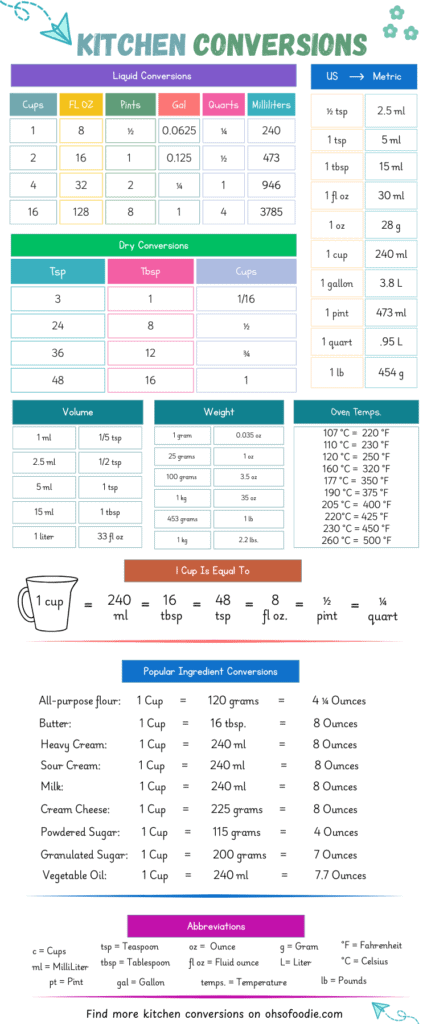Last Updated on August 14, 2024 by Toya
Understanding cooking measurements, equivalents, and conversions can sometimes feel overwhelming, but it doesn’t have to be! In this article (and subsequent FREE printable), you’ll see how to simplify the essentials of measuring and converting in the kitchen. I’ll be covering everything from metric to standard conversions, common measurement equivalents, and more! Plus, my FREE printable Kitchen Measurement Conversion Chart will surely come in handy whenever you need it!
Why Kitchen Conversions Matter
Recipes are written in various formats, often depending on the country of origin. In the United States, measurements are typically given in cups, tablespoons, and teaspoons. In contrast, many other countries use the metric system, where ingredients are measured in grams and liters. If you’re following a recipe that uses unfamiliar units, converting them accurately is crucial to ensure your dish turns out as intended.
Moreover, understanding conversions allows for flexibility in cooking. If you want to adjust a recipe to serve more or fewer people, knowing how to convert measurements can help you scale the ingredients appropriately without compromising the dish’s quality.
Basic Conversion Units
Here are some common conversions that every home cook should know:
- Volume Conversions:
- 1 cup = 8 fluid ounces (fl oz) = 240 milliliters (ml)
- 1 tablespoon (tbsp) = 3 teaspoons (tsp) = 15 milliliters (ml)
- 1 teaspoon (tsp) = 5 milliliters (ml)
- 1 pint = 2 cups = 16 fluid ounces = 480 milliliters
- 1 quart = 4 cups = 2 pints = 32 fluid ounces = 960 milliliters
- 1 gallon = 4 quarts = 128 fluid ounces = 3.8 liters
- Weight Conversions:
- 1 ounce (oz) = 28 grams (g)
- 1 pound (lb) = 16 ounces = 454 grams
- 1 kilogram (kg) = 2.2 pounds
- Temperature Conversions:
- Celsius to Fahrenheit: F = (C X 9/5) + 32
- Fahrenheit to Celsius: C = (F – 32) X 5/9
- Dry Ingredient Conversions:
- 1 cup of all-purpose flour = 120-130 grams
- 1 cup of granulated sugar = 200 grams
- 1 cup of brown sugar = 220 grams
- 1 cup of butter = 227 grams (or 2 sticks in the U.S.)
It’s important to note that dry ingredient conversions can vary based on the ingredient’s density. For instance, a cup of flour weighs less than a cup of sugar. For precise baking, it’s always better to use a kitchen scale to measure ingredients by weight rather than volume.

Practical Tips for Kitchen Conversions
- Invest in a Kitchen Scale:
A kitchen scale is an invaluable tool for accurate measurement. It allows you to measure ingredients by weight, which is especially useful for baking. With a scale, you can easily convert grams to ounces or vice versa. - Use Measuring Cups and Spoons Appropriately:
Liquid measuring cups are typically transparent and have a spout, making them ideal for measuring liquids like water, oil, and milk. Dry measuring cups are usually made of metal or plastic and are meant to be filled to the top for ingredients like flour, sugar, and grains. - Double-Check Your Math:
When scaling recipes up or down, it’s easy to make a mistake. Double-check your math, especially when converting fractions. For example, doubling 1/3 cup means you’ll need 2/3 cup, not 1/2 cup. - Keep a Conversion Chart Handy:
Consider printing out a conversion chart and keeping it in your kitchen. This way, you’ll always have quick access to common conversions, making your cooking process smoother. You can download my handy conversion chart for FREE here. - Understand Ingredient Substitutions:
Sometimes you might not have the exact ingredient a recipe calls for. Understanding conversions can help you substitute ingredients without altering the outcome too much. For example, if a recipe calls for 1 cup of buttermilk and you don’t have any, you can substitute with 1 cup of milk plus 1 tablespoon of lemon juice or vinegar.
Understanding kitchen conversions is a great skill that can greatly improve your cooking and baking experiences. Whether you’re following a recipe from another country, adjusting serving sizes, or simply trying to get your measurements just right, knowing how to convert measurements is key. With the right tools, a bit of practice, and a handy conversion chart, you’ll be well on your way to cooking with confidence.